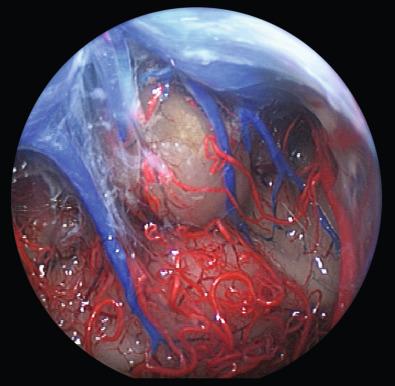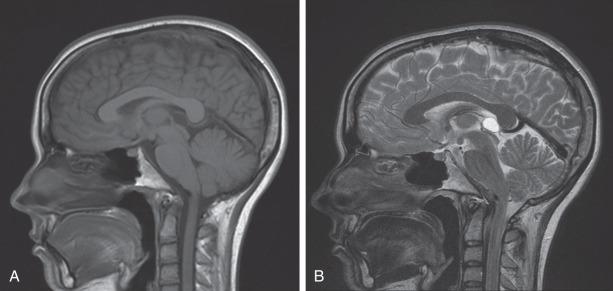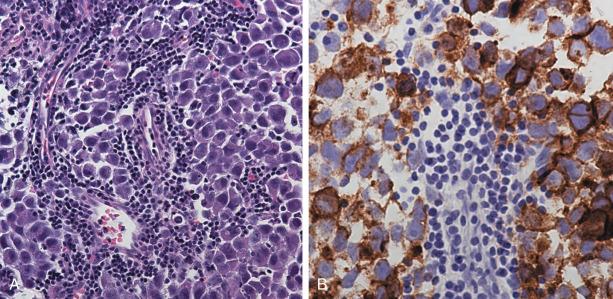Physical Address
304 North Cardinal St.
Dorchester Center, MA 02124
The pineal region is bordered posteriorly by the tentorial apex, inferiorly by the culmen of the cerebellar vermis, superiorly by the splenium of the corpus callosum, and anteriorly by the third ventricle, quadrigeminal plate, and midbrain tectum.
Pineal region tumors most commonly present with symptoms related to elevated intracranial pressure, hydrocephalus, and local compression to the dorsal midbrain.
An endoscopic biopsy and ETV is recommended in patients who present with hydrocephalus associated with a pineal/posterior IIIrd ventricular lesion that is consistent with a germ cell tumor on MRI.
The supracerebellar infratentorial approach should be used in tumors that are mostly dorsal to the tectum of the brainstem, confined to the posterior fossa and posterior IIIrd ventricle, without extensive extension into the anterior IIIrd ventricle.
Herophilus, a Greek physician, first reported the existence of the pineal gland in the setting of cadaveric dissection. He postulated at the time that its function was to modulate the flow “pneuma” or thought from the third to fourth ventricles. Aelius Galenus, or Galen of Pergamon, later theorized that the cerebellar vermis was in fact the valve for the flow of pneuma. The pineal gland to him was an underwhelming and insipid structural support for the deep cerebral venous system. It was not until the Renaissance era and the work of Rene Descartes that interest in the pineal gland made a resurgence, with Descartes referring to the only nonduplicated central nervous system (CNS) structure as “the seat of man's soul.” Over the next two centuries, anatomists began to study the gland's role in nonmammalian animals and its utility as a photosensory organ. These philosophic advancements coupled with the development of microscopic histology, electron microscopy, and dedicated neuroscientists like Cajal produced the basis of our current understanding for the gland's neurosecretory function. The identification and isolation of melatonin confirmed the gland's significance and ability to regulate circadian rhythms, inhibit gonadal development, and regulate menstruation, adrenal, and thyroid function. The gland also secretes other biogenic amines like serotonin and norepinephrine. It is innervated by noradrenergic sympathetic input from the superior cervical ganglion, and the retina via a polysynaptic pathway, with light stimulation inhibiting melatonin secretion. There is some evidence that undifferentiated and invasive pineal tumors can produce aberrant melatonin/circadian rhythms preoperatively. Rarely, a “postpinealectomy syndrome” can be observed postoperatively with recurrent headache and depression.
The “pineal region” is bordered posteriorly by the tentorial apex, inferiorly by the culmen of the cerebellar vermis, superiorly by the splenium of the corpus callosum, and anteriorly by the third ventricle, quadrigeminal plate, and midbrain tectum ( Fig. 42.1 ). This region is also referred to as the posterior incisural space. The gland sits in between the two superior colliculi. The roof of the posterior incisural space is composed of the lower surface of the splenium, the terminal part of the crura of the fornices, and the hippocampal commissure. The floor is composed of the culmen of the cerebellar vermis in the midline and quadrangular lobes of the cerebellar hemispheres laterally. The lateral wall components include the pulvinar, crus of the fornix, and medial surface the cerebral hemisphere including the posterior parahippocampal and dentate gyri. The main cistern of the region is the quadrigeminal cistern, which communicates with the posterior pericallosal cistern superiorly, the cerebellomesencephalic cistern inferiorly, the ambient cistern inferolaterally, and the retrothalamic cistern laterally. The pineal gland is considered a paired structure in the CNS and is part of the epithalamus, a posterior component of the diencephalon. It is connected to the third ventricle posteriorly by the habenular commissure superiorly and posterior commissure inferiorly. The habenula historically was thought to be located in the pineal stalk, though it actually entails a group of nuclei in the dorsal thalamus.

A number of important arteries are present in this space. The pineal arteries are branches of the medial posterior choroidal arteries that provide blood supply to the pineal gland laterally. The posterior cerebral artery (PCA) also courses through the lateral portion of the space and bifurcates into the calcarine and parieto-occipital arteries. The superior cerebellar artery (SCA) courses through the cerebellomesencephalic fissure and enters the pineal region. There are a large number of anastomoses between the SCA and PCA supplying the mesencephalon and structures in the posterior incisural space, affording a relative tolerance to manipulation and vascular injuries without major strokes or sequelae ( Fig. 42.2 ). The pineal region is home to a confluence of critically important venous structures, including the great vein of Galen, which is formed by the confluence of the internal cerebral veins (after exiting the velum interpositum) above the pineal gland and the basal veins of Rosenthal laterally from the ambient cisterns. There is also contribution from the posterior pericallosal veins, the internal occipital veins, the lateral and medial atrial veins, and the posterior longitudinal hippocampus veins. Finally, there is venous drainage into the vein of Galen from the infratentorial compartment via the vein of the cerebellomesencephalic fissure, which forms from the union of the paired veins of the superior cerebellar peduncle, the superior vermian veins, and the superior hemispheric veins. There are also smaller thalamic, epithalamic, and tectal veins that converge on the vein of Galen.

Pineal cysts represent a frequently benign and separate entity from pineal region tumors. On a microscopic level, pineal cysts can be detected in up to 25% to 40% of autopsies. Common presentation modalities include headache, mental status changes, and trauma; these are almost entirely asymptomatic lesions. Typical magnetic resonance (MR) radiographic appearance includes homogeneous cyst content, a thin (<2 mm) and smooth cyst rim without evidence of nodularity, and contrast enhancement in the rim ( Fig. 42.3 ), though up to 53% can have “atypical features” like septations or nodular enhancement. There are multiple theories regarding the etiology of pineal cysts; Cooper's hypothesis postulates that they originate from sequestration of the pineal recess of the third ventricle, corroborated by the occasional histopathologic findings of ependymal cells lining the cyst. Other theories argue that it is ischemia and degeneration of glial plaques after puberty that is responsible for cyst development, or alternatively degeneration of clusters of pinealocytes. They are more common in females than males, further supporting the theory of Klein and Rubenstein that hormonal influences may play a role in cyst enlargement/growth. Natural history studies have demonstrated a prevalence of 2.4% in girls and 1.5% in boys, with increased age in childhood connoting higher rates. Adults show slightly lower prevalence rates, with 0.08% in men and 1.1% in women. Rarely, pineal cysts can hemorrhage or enlarge, causing neurologic symptoms due to hydrocephalus, gaze paresis, or hypothalamic symptoms, and surgical intervention is considered in these cases. Given the mostly benign natural history, radiographic observation and conservative management in pediatric and adult populations is the most reasonable approach. However, patients with a pineal cyst can pose clinical challenges when they present with intractable headaches without associated hydrocephalus and eye movement abnormalities. The decision to observe versus operate after failed conservative management becomes a clinical judgment based on individual clinical characteristics.

In 1717, the French physician Charles Drelincourt was the first to describe a pineal tumor. Reports continued throughout the 19th century but only with the capacity to describe gross pathology. In 1875 the German pathologist Karl Weigert reported the first histology of a pineal tumor (teratoma). The late 19th century spawned reports of endocrine abnormalities and pineal tumors. Interestingly, although French neurologist and one of the pioneers in neuro-ophthalmology Henri Parinaud was the first to describe the clinical findings of the Parinaud syndrome, he could not at the time precisely define the anatomic mechanisms underlying the clinical sequelae.
Tumors located in the pineal region are rare and make up only 0.5% to 1.6% of all intracranial tumors. They are almost 10 times more common in children and account for 2.8% to 9% of all childhood CNS malignancies. According to the most recent World Health Organization (WHO) classification scheme from 2007, tumors in the pineal region can be divided into germ cell tumors (GCTs), pineal parenchymal tumors, tumors of supportive and adjacent structures, non-neoplastic tumor-like conditions, and metastases ( Table 42.1 ).
| Tumor | Origin | Frequency |
|---|---|---|
| Germ cell tumors | Rest of germ cells | ~60% |
| Germinoma Mature teratoma Immature teratoma Teratoma with malignant transformation Yolk sac tumor (endodermal sinus tumor) Embryonal carcinoma Choriocarcinoma |
||
| Pineal parenchymal tumors | Pineal glandular tissue | ~30% |
| Pineocytoma (WHO grade I) Pineal parenchymal tumor of intermediate differentiation (WHO grade II or III) Pinealoblastoma (WHO grade IV) Papillary tumor of pineal region |
||
| Tumors of supportive and adjacent structures | ~10% | |
| Astrocytoma Glioma (glioblastoma or oligodendroglioma) Medulloepithelioma |
Glial cells | |
| Ependymoma Choroid plexus papilloma |
Ependymal lining | |
| Meningioma | Arachnoid cells | |
| Hemangioma Hemangiopericytoma or blastoma Chemodectoma Craniopharyngioma |
Vascular cells | |
| Non-neoplastic tumor-like conditions | <1% | |
| Arachnoid cyst | Arachnoid cells | |
| Degenerative cysts (pineal cysts) | Glial cells | |
| Cysticercosis | Parasites | |
| Arteriovenous malformations | Vascularization | |
| Cavernomas Aneurysms of the vein of Galen |
||
| Metastases | Absence of blood-brain barrier | <0.1% |
| Lung (most common), breast, stomach, kidney, melanoma | ||
Pineal region tumors most commonly present with symptoms related to elevated intracranial pressure, hydrocephalus, and local compression to the dorsal midbrain. Accordingly, headache with nausea and vomiting (~80%) is commonly observed at diagnosis, alongside Parinaud syndrome and double vision (~50%–75%) ( Table 42.2 ). Isolated extraocular muscle cranial nerve impairment can be seen, with oculomotor nerve dysfunction most commonly. Parinaud syndrome (ie, dorsal midbrain syndrome) occurs due to compression of the rostral interstitial nucleus of the medial longitudinal fasciculus (riMLF) and the posterior commissure. It includes an array of ophthalmologic pathologies including upgaze paralysis, pseudo-Argyll Robertson pupils (light-near dissociation, with mid-dilated pupils unresponsive to light), convergence-retraction nystagmus elicited with a fast upgaze, eyelid retraction (ie, Collier's sign), and occasionally a conjugate down-gaze at baseline (ie, “setting sun sign”). Less commonly, with dilation of proximal cerebral aqueduct, sylvian aqueduct syndrome can be observed, which manifests as paralysis of downward or horizontal gaze. Tumor invasion into nearby structures can also produce symptoms. For example, thalamic invasion can yield contralateral hyperesthesia or paresthesias. Acute symptom development or worsening should prompt concern for pineal apoplexy. Endocrinologic changes can be seen on presentation, with 10% of male patients demonstrating precocious puberty due to either ectopic β-hCG secretion by germinoma or choriocarcinoma, or compression mass effect on the pituitary stalk.
| Clinical Sign/Symptom | Frequency |
|---|---|
| Headache Vomiting Lethargy Memory disturbance Hydrocephalus |
Common (~80%) |
| Nystagmus | Common (~60%–70%) |
| Parinaud sign Convergence Accommodation palsy Supranuclear upward glaze |
Frequent (~50%–75%) |
| Lid retraction Setting sun sign (Collier sign) |
Less frequent (~10%) |
| Endocrine disturbance Precocious puberty (in boys) Hypothalamic dysfunction Diabetes insipidus Polyphagia Isolated hypogonadism |
Less frequent (~10%) |
| Radiculopathy or myelopathy | Rare |
| Seizures | Rare |
| Hemihypesthesia/paresthesia | Rare |
| Thalamic pain | Rare |
| Extrapyramidal movement disorders | Rare |
Prior to pursuing a definitive surgical resection, or biopsy, patients with hydrocephalus and signs of increased intracranial pressure should be stabilized. The most urgent approach or emergency triage is to place an external ventricular drain (EVD), though cases of chronic hydrocephalus management may be temporally delayed for day(s). The standard approach at our institution is a simultaneously endoscopic pineal region biopsy and an endoscopic third ventriculostomy (ETV), which is performed acutely or electively. This is particularly useful if the clinical presentation and MRI are consistent with a radiosensitive or chemosensitive tumor, such as germinoma. Historically, some centers preferred to treat the hydrocephalus definitely prior to surgical resection and this may be appropriate in centers who do not possess endoscopic expertise or equipment. Alternatively, some surgeons perform preoperative ventriculoperitoneal shunt placement. Once acute hydrocephalus is triaged appropriately, plans can be made to resect the tumor.
Germ cell tumors (GCTs) constitute 60% of pineal region tumors. The pineal gland is home to 53% of all primary CNS GCTs, with a 15 : 1 male-to-female preference. Historically, the incidence of intracranial GCTs is approximately five- to eightfold higher in Japan and East Asia as compared to Western nations. Therefore in patients with Asian heritage additional preoperative consideration should be given to this diagnosis. This category of tumor can further be subdivided into germinomas and nongerminomatous germ cell tumors (NGGCTs).
Pure germinomas account for 55% to 65% of all intracranial germ cell tumors and are discovered synchronously in both the pineal gland and suprasellar region in 10% of the time, hence this unique imaging finding should prompt consideration of this diagnosis. These tumors do not secrete tumor markers in the serum but can produce subtle elevations in cerebrospinal fluid (CSF) levels of β-human chorionic gonadotropin (β-hCG) (up to 50 mIU/mL) due to occasional syncytiotrophoblastic cells, as well as placental alkaline phosphatase (PLAP). In fact, absence of alpha-fetoprotein (AFP) in both serum and CSF is mandatory for the diagnosis of a pure germinoma. Macroscopically, tumors are solid, light gray, and granular with poorly defined borders and local infiltration into the ventricles and subarachnoid space ( Fig. 42.4 ). Hemorrhage, necrosis, calcifications, and cystic changes are rare. Pathologically, tumor cells are round and resemble primitive germ cells, with large, vesicular nuclei, prominent nucleoli, a prominent clear, glycogen-rich cytoplasm, and focal areas of lymphocytic infiltration along fibrovascular septae ( Fig. 42.5 ). This immune-mediated reactive inflammation can cause granuloma formation. Immunohistochemistry labels positive for PLAP. These tumors are generally responsive to radiation therapy and chemotherapy, conferring an overall good prognosis with 5-year survival rates over 90%. Optimal tumor triage, management, and treatment plans are a subject of controversy, highlighting the importance of focused expert meetings such as the annual International Symposium on Central Nervous System Germ Cell Tumors.
![Figure 42.4, Midline sagittal section through the brain, with gross appearance of a germinoma. The tumor is infiltrating the brainstem at the level of the midbrain (A). Frontal section through the brain, gross appearance of a germinoma growing into the ventricle (B). Tumor cells of a germinoma in the postoperative cerebrospinal fluid representing a typical large cell with two prominent nucleoli (May-Grunwald Giemsa [MGG], ×600) (C). Figure 42.4, Midline sagittal section through the brain, with gross appearance of a germinoma. The tumor is infiltrating the brainstem at the level of the midbrain (A). Frontal section through the brain, gross appearance of a germinoma growing into the ventricle (B). Tumor cells of a germinoma in the postoperative cerebrospinal fluid representing a typical large cell with two prominent nucleoli (May-Grunwald Giemsa [MGG], ×600) (C).](https://storage.googleapis.com/dl.dentistrykey.com/clinical/PinealRegionTumors/3_3s20B9780323431408000421.jpg)

In general, an endoscopic approach is recommended in suspected germinoma for tissue biopsy, CSF sampling, and hydrocephalus treatment with an ETV for hydrocephalus. The approach is generally well tolerated with rare descriptions of complications such as catastrophic hemorrhage, iatrogenic tumor dissemination along operative corridors, and inaccurate or nondiagnostic biopsies. An endoscopic approach also affords an opportunity for ependymal surface inspection for direct or distant metastatic disease that may not be detected in contrasted MR imaging, and thus more accurate disease staging. Although germinomas are radio- and chemosensitive, there is a theoretic utility for surgical cytoreduction and the subsequent reduction of radiation doses and field volumes if microsurgery is the diagnostic modality. This may prevent some of the delayed neurodevelopmental and neuroendocrine dysfunction observed in pediatric patients treated with radiation therapy, though aggressive surgical resection remains a controversial topic in this patient population. Additionally, more extensive upfront resection affords more accurate histopathologic diagnosis, which can often reveal focal areas of NGGCTs, thereby redirecting management. Focal germinoma disease usually requires at least 50 Gy of radiation therapy, with craniospinal axis prophylactic radiation no longer advocated unless there is evidence of disseminated disease. Specific chemotherapy regimens include cyclophosphamide, cisplatin, and carboplatin. The precise role of chemotherapy remains to be elucidated; there is evidence supporting both a monotherapy approach without radiation, as well as adjuvant chemotherapy in an effort to reduce radiation doses.
Become a Clinical Tree membership for Full access and enjoy Unlimited articles
If you are a member. Log in here